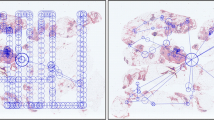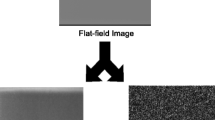Abstract
One of the advantages of digital mammography is to display mammograms on softcopy (electronic displays). Softcopy display of mammography is challenging because of the spatial and contrast resolution demands present in mammograms. We have designed and developed a softcopy mammography display application, Mammoview, which is capable of allowing radiologists to read mammograms as quickly and as accurately as they can on film alternators. We review the studies using Mammoview to elucidate the requirements of a successful softcopy display station. The design and development of the Mammoview softcopy display station are described in this article, and results of several studies using Mammoview are reported, including subjective feedback from Radiological Society of North America (RSNA) conference demonstrations, and clinical studies measuring performance in terms of speed and accuracy. Additional analysis of user interactions and user feedback is used to study the successes and shortcomings of mammography display stations like Mammoview. Overall, radiologist readings using Mammoview have been shown to be as fast and as accurate as readings using mammography film alternators. However, certain parts of the softcopy interface were more successful than their film counterparts, whereas others were less successful. Data analysis of the recorded human–computer interactions for the softcopy component of the clinical trial indicate statistically significant correlations between the difference in review time of softcopy versus alternator readings and three factors: the number of interactions, the reader, and the size of the image being reviewed. The first factor (number of interactions) suggests that simpler interfaces require less time to use; the second factor, the reader, supports previous findings that radiologists vary in how fast they read screening mammography studies; the third, size of image, suggests that the speed of softcopy review is increased relative to film readings when images are significantly larger than the display size. Feedback from radiologists using the system in clinical trials and at demonstration exhibits at RSNA indicated good acceptance of the interface and easy adaptation. Radiologists indicated that they felt comfortable using the interface, and that they would use such a softcopy interface in clinical practice. Finally, preliminary work suggests that the addition of a simple interaction to incorporate computer-aided detection (CAD) results would improve reading accuracy without significantly increasing reader times.







Similar content being viewed by others
References
LH Baker (1982) ArticleTitleBreast Cancer Detection Demonstration Project: five-year summary report. CA Cancer J Clin 32 194–225 Occurrence Handle1:STN:280:Bi2B3cjovFY%3D Occurrence Handle6805867
DV Beard P Bream ED Pisano et al. (1997) ArticleTitleA pilot study of eye movement during mammography interpretation: eyetracker results and workstation design implications. J Digit Imaging 10 14–20 Occurrence Handle1:STN:280:ByiB3Mfjt1Y%3D
DV Beard BM Hemminger JR Perry et al. (1993) ArticleTitleInterpretation of CT studies: single-screen workstation versus film alternator. Radiology 187 565–569 Occurrence Handle1:STN:280:ByyB3svnvVU%3D Occurrence Handle8475309
RL Birdwell DM Ikeda KF O’Shaughnessy et al. (2001) ArticleTitleMammographic characteristics of 115 missed cancers later detected with screening mammography and the potential utility of computer-aided detection. Radiology 219 192–202 Occurrence Handle1:STN:280:DC%2BD3M7oslKgsQ%3D%3D Occurrence Handle11274556
HP Chan B Sahiner MA Helvie et al. (1999) ArticleTitleImprovement of radiologists’ characterization of mammographic masses by using computer-aided diagnosis: an ROC study. Radiology 212 817–827 Occurrence Handle1:STN:280:DyaK1MvgslKqsg%3D%3D Occurrence Handle10478252
SA Feig MJ Yaffe (1996) ArticleTitleCurrent status of digital mammography. Semin Ultrasound CT MR 17 424–443 Occurrence Handle1:STN:280:ByiD2M7jslU%3D Occurrence Handle8896109
TW Freer MJ Ulissey (2001) ArticleTitleScreening mammography with computer-aided detection: prospective study of 12,860 patients in a community breast center. Radiology 220 781–786 Occurrence Handle1:STN:280:DC%2BD3Mvotlansw%3D%3D Occurrence Handle11526282
Hemminger BM: Softcopy Display Requirements for Digital Mammography. Medical Imaging 2002: Visualization, Image-Guided Procedures, and Display 4681, 2002
BM Hemminger S Zong KE Muller et al. (2001) ArticleTitleImproving the detection of simulated masses in mammograms through two different image-processing techniques. Acad Radiol 8 845–855 Occurrence Handle10.1016/S1076-6332(03)80762-6 Occurrence Handle1:STN:280:DC%2BD3MnnvVahug%3D%3D Occurrence Handle11724039
AB Hollingsworth LD Taylor DC Rhodes (1993) ArticleTitleEstablishing a histologic basis for false-negative mammograms. Am J Surg 166 643–648 Occurrence Handle1:STN:280:ByuD1MbktVI%3D Occurrence Handle8273842
E Krupinski H Roehrig T Furukawa (1999) ArticleTitleInfluence of film and monitor display luminance on observer performance and visual search. Acad Radiol 6 411–448 Occurrence Handle1:STN:280:DyaK1MzjvVemtw%3D%3D Occurrence Handle10410166
I Leichter S Fields R Nirel et al. (2000) ArticleTitleImproved mammographic interpretation of masses using computer-aided diagnosis. Eur Radiol 10 377–383 Occurrence Handle10.1007/s003300050059 Occurrence Handle1:STN:280:DC%2BD3c7jtV2htA%3D%3D Occurrence Handle10663772
InstitutionalAuthorNameNational Electrical Manufacturers Association (2001) Digital Imaging and Communications in Medicine (DICOM) International Standard. http://medical.nema.org National Electrical Manufacturers Association Rosslyn, VA
ED Pisano J Chandramouli BM Hemminger et al. (1997) ArticleTitleDoes intensity windowing improve the detection of simulated calcifications in dense mammograms? J Digit Imaging 10 79–84, Occurrence Handle1:STN:280:ByiA3cfhvFI%3D Occurrence Handle9165422
ED Pisano J Chandramouli BM Hemminger et al. (1997) ArticleTitleThe effect of intensity windowing on the detection of simulated masses embedded in dense portions of digitized mammograms in a laboratory setting. J Digit Imaging 10 174–182 Occurrence Handle1:STN:280:DyaK1c%2FmtFGguw%3D%3D Occurrence Handle9399171
ED Pisano EB Cole BM Hemminger et al. (2000) ArticleTitleImage processing algorithms for digital mammography: a pictorial essay. Radiographics 20 1479–1491 Occurrence Handle1:STN:280:DC%2BD3cvpvVajuw%3D%3D Occurrence Handle10992035
ED Pisano EB Cole EO Kistner et al. (2002) ArticleTitleInterpretation of digital mammograms: comparison of speed and accuracy of soft-copy versus printed-film display. Radiology 223 483–488 Occurrence Handle11997557
ED Pisano EB Cole S Major et al. (2000) ArticleTitleRadiologists’ preferences for digital mammographic display. The International Digital Mammography Development Group. Radiology 216 820–830 Occurrence Handle1:STN:280:DC%2BD3cvktValtw%3D%3D Occurrence Handle10966717
ED Pisano M Yaffe (1998) ArticleTitleDigital mammography. Breast Disease 10 127–136
ED Pisano S Zong BM Hemminger et al. (1998) ArticleTitleContrast limited adaptive histogram equalization image processing to improve the detection of simulated spiculations in dense mammograms. J Digit Imaging 11 193–200 Occurrence Handle1:STN:280:DyaK1M%2FmsVGiug%3D%3D Occurrence Handle9848052
DT Puff R Cromartie ED Pisano (1992) ArticleTitleEvaluation and optimization of contrast enhancement methods for medical images. Proc SPIE: Visualization in Biomedical Computing Conference 1808 336–346
DT Puff ED Pisano KE Muller et al. (1994) ArticleTitleA method for determination of optimal image enhancement for the detection of mammographic abnormalities. J Digit Imaging 7 161–171 Occurrence Handle1:STN:280:ByqC287kvVU%3D Occurrence Handle7858011
J Rosenman CA Roe R Cromartie et al. (1993) ArticleTitlePortal film enhancement: technique and clinical utility. Int J Radiat Oncol Biol Phys 25 333–338 Occurrence Handle1:STN:280:ByyC3s7mtVM%3D Occurrence Handle8420883
F Shtern (1992) ArticleTitleDigital mammography and related technologies: a perspective from the National Cancer Institute. Radiology 183 629–630 Occurrence Handle1:STN:280:By2B283mslY%3D Occurrence Handle1584908
F Shtern DW Winfield F Behlen et al. (1999) ArticleTitleReport of Working Group on Digital Mammography: Digital Displays and Workstation Design. Academic Radiology 6 197–218
M Weibrecht G Spekowius P Quadflieg et al. (1997) ArticleTitleImage quality assessment of monochrome monitors for medical softcopy display. Proc SPIE 3031 232–244
Acknowledgements
The clinical trial evaluating Mammoview versus film display was conducting in the Radiology Research Laboratory and supported by the mammography research group in the Department of Radiology at UNC-CH, directed by Dr. Etta Pisano. Original acquisition of the Fischer digital mammography cases was supported by a grant from Fischer Digital Imaging. Work evaluating the incorporation of CAD results into softcopy display was supported by and done in collaboration with Qualia Computing, developers of the CADx computer-aided detection product for digital mammography. Printing of hard copy films was made possible by the Eastman Kodak Corporation. Anne Bauers helped with the secondary analyses. The Odum Institute for Research in Social Sciences at UNC-CH, especially Jun Koo and Chris Wiesen, aided us in performing the statistical regression analysis. A preliminary version of this work was published in the SPIE Medical Imaging Conference Proceedings.8 In addition, the following grants partially supported this work: Grey Scale Image Processing for Digital Mammography, National Cancer Institute, National Institutes of Health, grant RO1 CA60193-05, and Evaluation of Digital Mammography Display, U.S. Army Medical Research and Material Command, grant DAMD 17-94-J-4345.
Author information
Authors and Affiliations
Corresponding author
Rights and permissions
About this article
Cite this article
Hemminger, B.M. Soft Copy Display Requirements for Digital Mammography . J Digit Imaging 16, 292–305 (2003). https://doi.org/10.1007/s10278-003-1659-6
Accepted:
Published:
Issue Date:
DOI: https://doi.org/10.1007/s10278-003-1659-6




